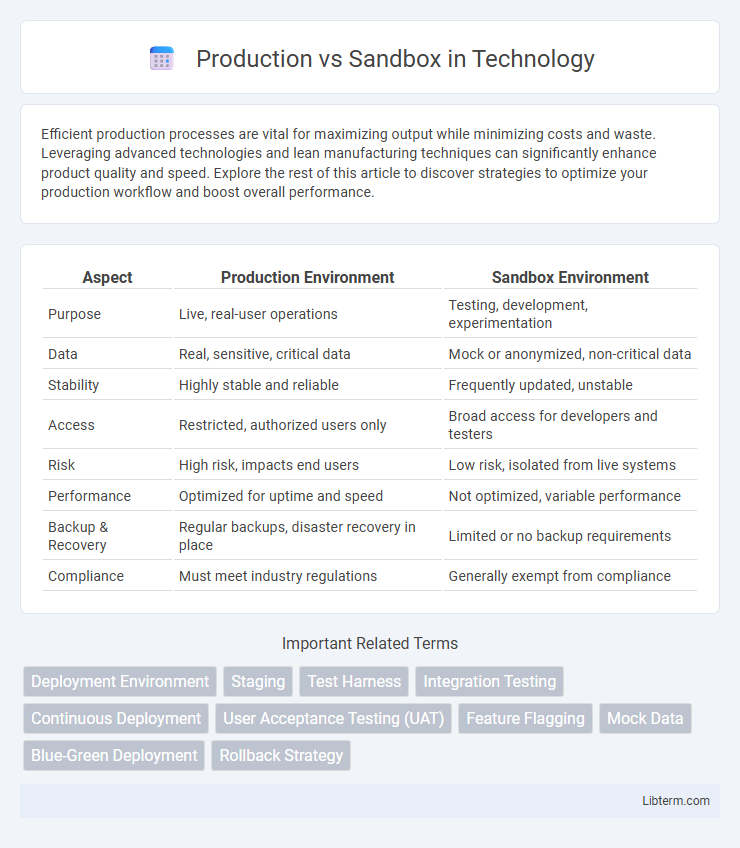Efficient production processes are vital for maximizing output while minimizing costs and waste. Leveraging advanced technologies and lean manufacturing techniques can significantly enhance product quality and speed. Explore the rest of this article to discover strategies to optimize your production workflow and boost overall performance.
Table of Comparison
| Aspect | Production Environment | Sandbox Environment |
|---|---|---|
| Purpose | Live, real-user operations | Testing, development, experimentation |
| Data | Real, sensitive, critical data | Mock or anonymized, non-critical data |
| Stability | Highly stable and reliable | Frequently updated, unstable |
| Access | Restricted, authorized users only | Broad access for developers and testers |
| Risk | High risk, impacts end users | Low risk, isolated from live systems |
| Performance | Optimized for uptime and speed | Not optimized, variable performance |
| Backup & Recovery | Regular backups, disaster recovery in place | Limited or no backup requirements |
| Compliance | Must meet industry regulations | Generally exempt from compliance |
Introduction to Production and Sandbox Environments
Production environments serve as the live platform where real users interact with fully functional applications, ensuring stability, security, and performance under actual operating conditions. Sandbox environments provide isolated, controlled spaces for developers and testers to experiment with new features, debug code, and perform quality assurance without impacting the production system. Distinguishing these environments is crucial for maintaining application integrity and enabling safe innovation.
Key Differences Between Production and Sandbox
Production environments host live applications and real user data, ensuring high availability and security for mission-critical operations. Sandbox environments provide isolated, controlled spaces for testing, development, and experimentation without impacting live systems or data integrity. Unlike production, sandboxes allow unlimited changes, debugging, and validation before deployment to prevent errors and ensure stability.
Purpose and Use Cases of Sandbox Environments
Sandbox environments serve as isolated testing grounds where developers and QA teams can safely experiment with new code, features, or configurations without impacting live production systems. These environments facilitate debugging, performance testing, and integration trials to ensure stability and security before deployment. Unlike production environments that handle real user data and critical operations, sandboxes enable risk-free innovation and validation within a controlled, non-production setting.
The Role of Production in Live Operations
Production environments ensure stability and reliability for live operations, hosting real-time data and user interactions critical for business continuity. Unlike sandbox environments used for testing and development, production systems demand rigorous monitoring and robust security protocols to minimize downtime and prevent data breaches. Efficient production management directly impacts user experience and operational performance in live settings.
Data Management: Production vs Sandbox
Production environments handle live data with strict governance, ensuring data integrity, security, and compliance to support real-time business operations. Sandbox environments use anonymized or synthetic data, allowing developers and testers to experiment, validate, and troubleshoot without risking sensitive information or system stability. Effective data management in these environments demands role-based access controls and regular data refreshes to balance innovation with data protection.
Security Considerations in Both Environments
Production environments demand stringent security measures, including robust access controls, real-time monitoring, and strict data encryption to protect sensitive customer information and adhere to compliance standards. Sandbox environments, while more flexible for testing and development, require carefully defined permissions and data masking to prevent unauthorized access and leakage of proprietary or sensitive data. Implementing role-based access control (RBAC) and isolating network permissions in both environments minimizes risks and ensures secure operations throughout the software development lifecycle.
Testing and Quality Assurance: Sandbox Benefits
Sandbox environments provide isolated testing spaces that replicate production settings without risking live data or system stability. These environments enable rigorous quality assurance by allowing developers and testers to simulate real-world scenarios, identify bugs, and validate new features before deployment. Utilizing sandbox testing reduces downtime and enhances the reliability of production systems through controlled experimentation.
Migration Strategies from Sandbox to Production
Migration strategies from Sandbox to Production prioritize data integrity and minimal downtime by employing incremental deployment and thorough testing phases. Utilizing version control systems and automated deployment pipelines ensures consistency between environments, reducing risks of configuration drift. Effective migration also involves rollback plans and validation scripts to quickly address any post-migration issues in the Production environment.
Common Challenges in Environment Management
Managing Production and Sandbox environments often involves challenges such as data synchronization discrepancies, which can lead to inconsistent testing and development outcomes. Ensuring proper access controls and security measures across both environments is critical to prevent unauthorized changes and protect sensitive information. Resource allocation conflicts frequently arise, impacting system performance and slowing down deployment cycles in both setups.
Best Practices for Production and Sandbox Usage
Production environments should strictly host live applications and real user data to ensure stability, security, and optimal performance. Sandbox environments are ideal for testing new features, debugging, and experimentation without impacting end users or data integrity. Best practices recommend isolating sandbox work from production by using separate credentials, regularly refreshing sandboxes with production data, and implementing robust access controls to prevent unauthorized changes in production.
Production Infographic

 libterm.com
libterm.com